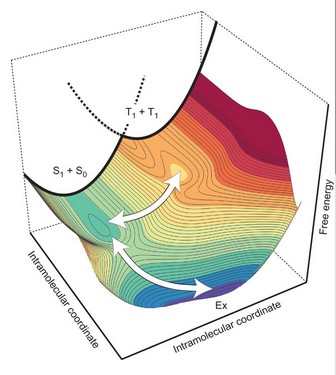Jan
25
Solar Collection Efficiency May Exceed 30 Percent
January 25, 2018 | 1 Comment
The team, led by Professor Timothy Schmidt at UNSW, has been looking at ways to capture the energy of visible light that is currently wasted due to the limitations of silicon, which is only able to access approximately 25% of the solar spectrum.
To illustrate, silicon on its own is only able to use of about half the energy of green light, which is the peak of the solar spectrum in terms of energy availability.

Schematic Marcus–Hush–Morse free-energy surface of the SF–TTA process. Use the Nature Chemistry link below for more details. Image Credit: ARC Center of Excellence in Exciton Science. Click image for the largest view.
One of the ways to reduce this waste is through the design of materials that can be coated on top of silicon to capture some of the energy of light that silicon cannot. By incorporating singlet exciton fission, a process that generates two excitons from a single photon, it is hoped that silicon solar cell efficiencies can be boosted beyond 30%.
The work, published in Nature Chemistry, examines the role of a short-lived (~8 billionths of a second), excited molecular complex called an excimer in singlet exciton fission and overturns previous thinking by demonstrating that these singlet fission materials must avoid excimer formation to reach full potential in enhancing photovoltaic energy conversion.
Professor Schmidt explains, “As we look to find ways to bring down the cost of solar energy harvesting, we should be designing materials that avoid excimer formation.”
Professor Marc A. Baldo, member of the Center’s International Scientific Advisory Committee and Director of the Center of Excitonics at MIT expands the background with, “Singlet exciton fission has enormous promise for improving the efficiency of solar cells, but its dynamics are complex and not well understood. By comparing the fission process when it is run both forwards and in reverse, Schmidt, et al. have performed a remarkably simple test of theories for the mechanism of exciton fission.”
“Their result suggests that what had previously been considered as an intermediate in the fission process may in fact be a source of loss. With this understanding Schmidt, et al. propose an important new direction in our search for materials that enable higher efficiency solar cells.”
The press release is way too brief for most folks to get what is going on. The idea the research is forming up is that solar panels need made to add “singlet exciton fission” while at the same time avoiding “excimer formation”. What the research has accomplished is showing fission materials need to not make excimer formation.
Your humble writer hopes that simplifies things, but the news in this is massive because the time honored solar efficiency limit looks to be blown now. That’s news.
While it looks like the chemistry is mastered, there is a very long way to go in materials science research and engineering. But go we will.
Comments
1 Comment so far


While it looks like the chemistry is mastered, there is a very long way to go in materials science research and engineering. But go we will.